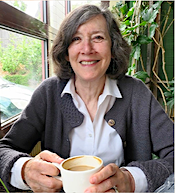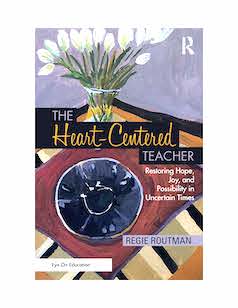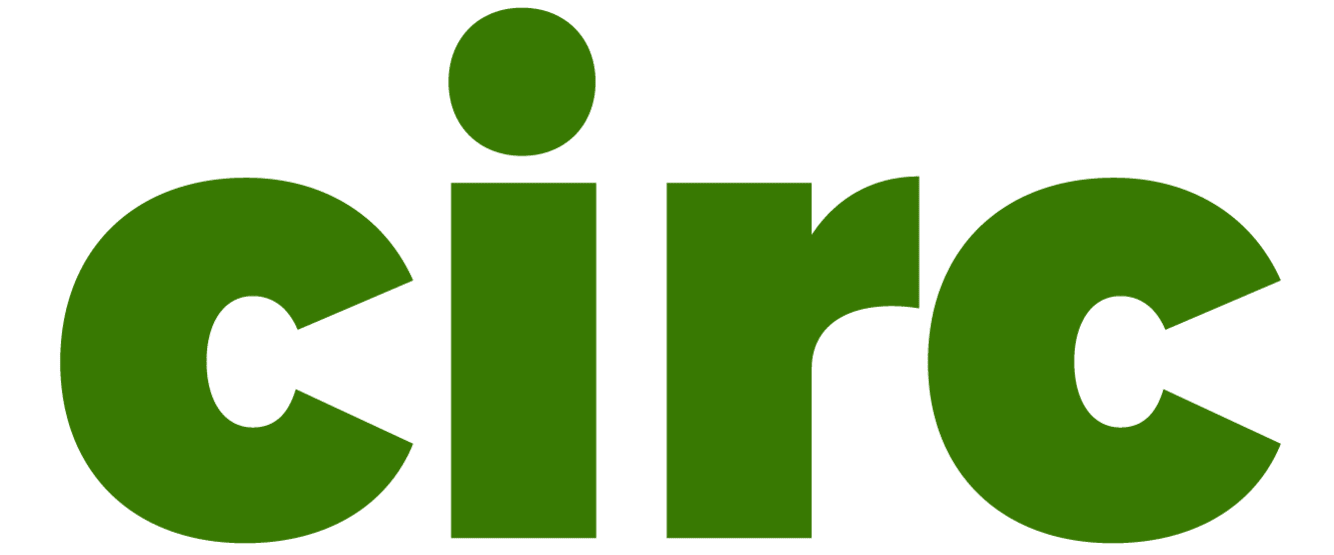“You are welcome here.” It’s the message every student longs to hear as they walk through your classroom door for the very first time. It’s the warm introduction to a culture of belonging that will energize learning throughout the year. Literacy leader Regie Routman shares the seven components she believes are essential to creating such a culture.
By Regie Routman
 Engaging ALL learners in excellent, equitable, and joyful practices has been my life’s work and the work of so many of us. Ultimately, for our students to be well educated, activist citizens who lead fulfilling lives, they need to attend schools where fostering a culture of belonging becomes the character of the school.
Engaging ALL learners in excellent, equitable, and joyful practices has been my life’s work and the work of so many of us. Ultimately, for our students to be well educated, activist citizens who lead fulfilling lives, they need to attend schools where fostering a culture of belonging becomes the character of the school.
It’s a school where every student feels safe, cared for, seen, empowered, has the opportunity to make their voice heard, is offered choices in “showing what you know,” and is treated with dignity and respect. Especially in today’s uncertain times, creating and sustaining a school culture of belonging is a necessity for student and teacher wellbeing and high achievement.
So how can we make that happen? Here are seven essentials drawn from my work with schools where educators teamed together to meet this goal.
1. Develop a culture of belonging and trust right from the start.
Creating spaces of belonging starts in pre-school, and it begins with fairness. MacArthur Prize-winning educator Vivian Paley, author of the classic You Can’t Say You Can’t Play, writes about how, in most schoolyards, “exclusion is written into the game of play. And play, as we know, will soon be the game of life.” (p. 20)
Yet Paley and her kindergartners were able, with her guidance, to continuously dialogue around new a rule – “You can’t say you can’t play” – and come to accept it, even embrace it. When an adult complained the rule was unrealistic, Paley responded, “Maybe our classrooms can be nicer than the outside world.” (p.100)
I am particularly struck by Paley’s statement:
“We must be told, when we are young, what rules to live by. The grownups must tell the children early in life so that myth and reality proclaim the same message while the children are still listening.” (p. 110)
Going beyond the classroom, we can also create a district-wide culture of belonging where all members of a school community feel valued, included, and welcome.
Take, for example, Walnut Valley Unified School District in Walnut, CA, a suburb of Los Angeles comprised of 14,200 students: 60% Asian American Pacific Islander (AAPI), 25% Hispanic, and 15% other. The district has been ably led for the past 12+ years by Superintendent Bob Taylor and Assistant Superintendent of the Educational Services Division Jeanette Koh.
The way they take the inclusion theme to heart every year is incredible. They create a back-to-school event for all members of the school community, to ensure that each feels valued and welcome. Every staff member attends the event the week before school officially begins. Attendees include not just certificated staff, such as teachers, principals, and psychologists; they also include classified staff, such as secretaries, custodians, bus drivers, nutrition workers. Bob Taylor elaborates:
We strive to create a culture across the district that reflects a “You are welcome here” environment for our entire community, including our employees. We have found over many years that happy staff members lead to greater outcomes, including our primary one, student achievement.
And what an inclusive and festive time the most recent event was! For the 2024-2025 school year, they created this theme for inclusion: You are welcome here.
There was a breakfast and catered refreshment, a welcome message by Dr. Taylor, live music provided by high school students, cheering of Teacher of the Year honorees, a bookshop set up with balloons where every staff member received a professional book, and a “You are welcome here” shirt. Each teacher also got to choose a children’s book for their classroom. Every staff member could choose from a selection of books representing the demographics of the students they serve.
The festive atmosphere of the event is intentional, recognizing that how we begin the school year sets the tone for the whole year. The “You are welcome here” event is also a heartfelt celebration and recognition that every staff member’s contribution is valued, that every encounter we have with a student is an opportunity to make that student’s day better.
Jeanette Koh says, “Connect before content. If students don’t feel comfortable in the learning space, they won’t engage in the lesson.” Wise words, and they are true for teachers as well.
2. Make school a sanctuary.
The moral and social dimensions of belonging determine what kind of society we live in. We are all born with full human rights and the potential to treat others with humanity, respect, and dignity. At least while students are in our care, we who are teachers, educators, and caregivers must ensure that school is a sanctuary where students and their families, cultures, traditions, language, strengths, and interests are valued, affirmed, and celebrated.
Students, teachers, teacher-leaders, principals – and all who work in schools – spend much of their waking hours in a school setting, so it’s essential we provide a risk-taking environment that is physically, socially, and emotionally safe. For many students, it may be their only place where they feel safe.
If we want students and teachers to treat each other kindly every day, then we must talk about and put into practice the qualities that accompany kindness – generosity, forgiveness, holding high expectations for all learners, compassion, empathy, and second chances.
Without daily acts of kindness, nothing of lasting value is possible. For students, it’s about kindness to others and lending a hand to a peer, being a respectful team member. When I am not sure of a course of action to take, whether it’s in my personal life or my professional one, I ask myself, “What is the most generous thing I can do or say at this time?” In my personal life, it might mean forgiving a friend for forgetting my birthday or not getting defensive when criticized. For our students, our generosity might mean extending recess, giving additional time for an assignment turned in late, or taking the time to listen to a student who is distraught.
3. “See” every learner.
Perhaps, most of all, to truly feel like we belong we need to be and feel seen. “Seeing” means looking through lenses that capitalize on strengths and possibilities, rejecting a mentality of differences-as-deficits, and providing equitable opportunities for all. Being seen means I know who you are. I am here for you. I appreciate your gifts, your strengths and interests. I understand you, and I believe to be fully understood is life-affirming. It is part of our job – as educators, community members, caregivers, and citizens – to look beyond the data and find ways to make our students, colleagues, and families feel seen and welcome every day.
Once learners feel truly seen, they will open their hearts and minds to us. During the pandemic, at his request, I tutored Ted, a 54-year-old man who had lost his job as a custodian, was in a fragile state of mind, and wanted to use his days to “learn to read and make his life more interesting.” Our twice-weekly sessions took place using our phones as Ted had never used a computer. We began by getting to know each other; we shared stories from our lives including our struggles. The longer we worked together, the clearer and deeper my sight became and the more I was able to joyfully teach him. (Routman, 2024).
One crucial way to see our students is to listen more, to process with empathy – listening to hear vs. listening to respond. In a setting where students’ voices are encouraged and celebrated, teachers are listening closely and students respond by being more willing to speak out and share their thinking.
4. Prioritize books, libraries, and stories.
If we want students to feel fully welcome in our schools and classrooms, it is critically important they see themselves and their cultures in the books we read aloud to them, in the stories and texts we write and read together, and in the content we teach.
We are obligated as caring human beings to provide educational opportunities for all students. Indigenous peoples, people of color, English learners, immigrants, and all students must find themselves represented in history, books, and the resources we use.
It’s crucial we make engaging texts available and accessible to students through school and classroom libraries and other venues. Books, stories, and poetry are foundational for expanding thinking, widening our world views, savoring inspiring language, and enriching our lives. To my mind, there is almost nothing more valuable and joyful than falling in love with a great book. We must create that possibility for all of us and do what we can to promote a culture and love of reading with students and staff.
Daily reading aloud, writing books with children, investing in diverse books and libraries are all necessary for students to feel they belong, that they see themselves in books, that they feel affirmed and develop a wider, empathetic, and compassionate world view.
Stories promote positive and joyful learning. Carlene Lantz, an enthusiastic, experienced librarian and former first and second grade teacher, teaches in a rural district in central Virginia. While the school system has historically served a White and conservative population, its school enrollment is becoming an increasingly diverse group that also includes Muslim, Russian, and Latino students. Carlene believes that students should be free to choose the books they want to read, including what she calls “self-esteem” books. She says, “When a struggling reader checks out the thickest Harry Potter volume, I think of it as their self-esteem book. It’s a celebration that they want to be seen as a reader, they value books, and they have hope for reading in their future.”
As many books have been banned and pulled from bookshelves in classrooms and the school library, Carlene makes it a priority to read aloud with all grade levels and to feature kindness-themed books and books about different kinds of families and then to discuss issues raised in the books with questions like who deserves to be treated kindly?
“I am helping to build awareness of a community in our school,” she explained in a recent email. “I want students to know and respect the people they go to school with, that we’re all different, yet the same, and we all belong. I think a lot about what I can do to help make things right.”
Carlene’s kindness and empathy bulletin board – “You are a piece of our puzzle” – includes mirrors so students see their actual selves included. It is interesting to note that while parents in the school and district have the option to restrict what their child signs out from the library, at the time we talked only one parent at Carlene’s school had done so during the school year, and it was for “no scary books.”
5. Create an environment that empowers students.
When students – and teachers, teacher-leaders, and principals too – feel empowered to make decisions, they see school differently. It’s not just a place they are required to be and to follow rules. It’s a place where they have agency to offer suggestions, have their ideas taken seriously, develop their curiosity, and make their school lives better for people beyond themselves.
A great place to start is to welcome collaboration and cooperation in the classroom by fostering reciprocity. By that I mean to believe and put into action that we are not the only teachers in the room, the sole source of knowledge, that we all have much to learn from each other. We can strive to ensure the tone and mindset we hold is “our classroom,” and not “my classroom.” We can routinely seek ways to give students agency through soliciting their ideas, for example, on classroom design, creating comfortable reading spaces, deciding what goes on the walls, creating anchor charts together, giving choices in how students can “show what they know.”
Consider inviting students to co-create the school library space as a way to empower them. That’s exactly what happened when Wisconsin principal Matt Renwick and library media specialist Micki Uppena guided their 4th and 5th grade students to make many of the decisions about the school library.
Students had to apply for the job, which included interviewing kindergarten through grade 5 students to learn their reading preferences. Students used iPads and Google Forms to record input. (The digital forms included images of book covers to ensure accessibility for younger students who couldn’t yet read.) Other jobs were selecting new books to be ordered, and redesigning the library to best serve students. Matt wrote about the impact of the project:
Similar to when kids get lost in a book, students who were fully engaged in the book budget project seemed to forget they were in school. They thought about what their peers would want to read instead of only thinking about their own interests. There was a deeper purpose to the book selection process because the work was meaningful. The students became librarians. (Renwick & Uppena, 2023.)
Micki noted that a few students who were typically disengaged during the classroom literacy block would regularly come to school early and head down to the library to see what they could do for the project. They began to think bigger about how the library might best serve all users. They helped unpack deliveries and put school labels on their new books. “They honored personal and peer’s interests and diverse cultural identities to create a more inclusive, equitable, and welcoming school library.” (Routman, 2024, p. 246.)
6. Embrace curriculum as conversation.
“Curriculum as conversation” includes all we do to create an intellectual classroom culture that promotes inquiry, dialogue, and deep thinking. The types and depth of conversations and who’s doing the talking speak volumes about what’s going on in our classrooms. “If we do not structure the curricular domain so that students can enter the discourse, the knowledge they gain will remain decontextualized and unproductive.” (Applebee, 1996) As well, what students are discussing must be relevant, engaging, and worth their time.
We want to structure our classrooms so that students feel welcome to voice their opinions without fear of failure and to make the work interesting and relevant so we are cultivating their curiosity in language arts and across the content areas. It’s also necessary we make it possible for multi-lingual learners to enter the conversations and boost and accelerate their language development through more opportunities, with structured support.
A technique I have found very powerful – especially when we are supporting students as writers – is scaffolded conversations. We teachers put the language in the student’s ears to help begin their thinking-writing-process. We might say, for example, “How about if we say it this way?” We begin by teaching students how to infer, question the author, explain, draw conclusions and paraphrase by first demonstrating how it’s done. We share our thinking out loud, then provide many guided experiences, such as partner and small group work. As a result, all students grow in confidence as thinkers, speakers and language users.
7. Embed ongoing professional learning.
In every school I have ever worked in, ongoing and embedded professional learning has been the vehicle for bringing teachers and principals together in a shared and comprehensive vision for teaching and learning.
Reading and discussing professional articles and books, examining data with the goal of noticing strengths and needs at and across grade levels and content areas, determining what areas need attention first, and prioritizing joy in learning have raised the level of conversations, teaching, learning, and living.
Teaching can be an exhausting job. It’s too demanding to be done well in isolation. Developing camaraderie, deep knowledge, and a shared commitment to do better – based not just on research but on shared beliefs, principled practices, and informed experience – creates learning communities where teachers continuously learn from each other and support each other.
My literacy collaboration with several provinces in Winnipeg, Manitoba since 2008 has been the most satisfying work of my lifetime. (Routman, 2018) While our initial goal was to improve the teaching of writing, and that happened writ large, the sense of belonging as we pursued a worthwhile goal sustained and expanded the work. It was the growth of knowledge through schoolwide, collaborative, weekly, professional learning that led us to move beyond standards and programs – to use them as a framework – and to align curriculum and standards with real-world issues that mattered to the students.
Rather than teach reading and writing as separate subjects, we integrated almost all nonfiction reading and writing into social studies and science. For example, we spent a whole year of focus and study on “Environmental Citizenship and the Responsibilities of Citizens,” and within that topic we studied endangered animals, environmental stewardship, and sustainability.
The extensive 60-page lesson plan we developed included goals and learning outcomes, day-by-day detailed lesson planning, teacher reflection, focus questions, teacher language, demonstration lessons, final products, and much more. Although the lesson plan is written for a grades 2-3 class, it is applicable and adaptable for K-12. (Richardson and Routman, 2018)
 “You Are Welcome Here” T-shirt giveaway – Walnut Valley Unified School District
“You Are Welcome Here” T-shirt giveaway – Walnut Valley Unified School District
Make the work joyful and authentic.
These are my seven essentials. I hope they are meaningful in your work. There is no formula or packaged program for the kind of teaching and community building that engages kids, cultivates their curiosity, and promotes and changes their view of what’s possible – for themselves and for others. We fueled the learning in Winnipeg by making the work authentic and relevant to learners’ current and future lives, sparking their engagement, effort, and continuing curiosity. Perhaps most important, the work was joyful, uplifting for all of us, teachers and students alike.
References
Applebee, A.N. (1996). Curriculum as conversation: Transforming traditions of teaching and learning. The University of Chicago Press. (p. 20)
Gawande, A. (June 2, 2018). Curiosity and what equality really means. Commencement address at U.C.L.A Medical School, The New Yorker.
The New York Times, “Facts of Interest,” (December 26, 2022)
Paley, V. G. (1992). You can’t say. You can’t play. Harvard University Press.
Renwick, M. & Uppena, M. (2023). The School Library Project: Empowering readers through responsibility, support, and trust. The WSRA Journal, 60(1), 59-65
Richardson, T. & Routman, R. 2018. Lesson plan: Environmental citizenship and the responsibilities of citizens. Stenhouse at Routledge.
Routman, R. (2024). The heart-centered teacher: Restoring hope, joy, and possibility in uncertain times. Routledge, (2-9 and 135-145 for how I taught an adult non-reader to read and enjoy books.)
Routman, R. (2018). Literacy essentials: Engagement, excellence, and equity for all learners. Stenhouse at Routledge.
 Regie Routman is the author of a dozen books for educators, most recently The Heart-Centered Teacher: Restoring Hope, Joy, and Possibility in Uncertain Times. (Routledge, 2024). She is a mentor teacher and coach who works and collaborates virtually and conversationally, side by side with teachers, principals and educators at all levels in diverse schools, districts, and provinces. For more information about her work, her books and resources, and how to contact her see regieroutman.org. Also listen in to her Crucial Conversations video podcast series with educators.
Regie Routman is the author of a dozen books for educators, most recently The Heart-Centered Teacher: Restoring Hope, Joy, and Possibility in Uncertain Times. (Routledge, 2024). She is a mentor teacher and coach who works and collaborates virtually and conversationally, side by side with teachers, principals and educators at all levels in diverse schools, districts, and provinces. For more information about her work, her books and resources, and how to contact her see regieroutman.org. Also listen in to her Crucial Conversations video podcast series with educators.




